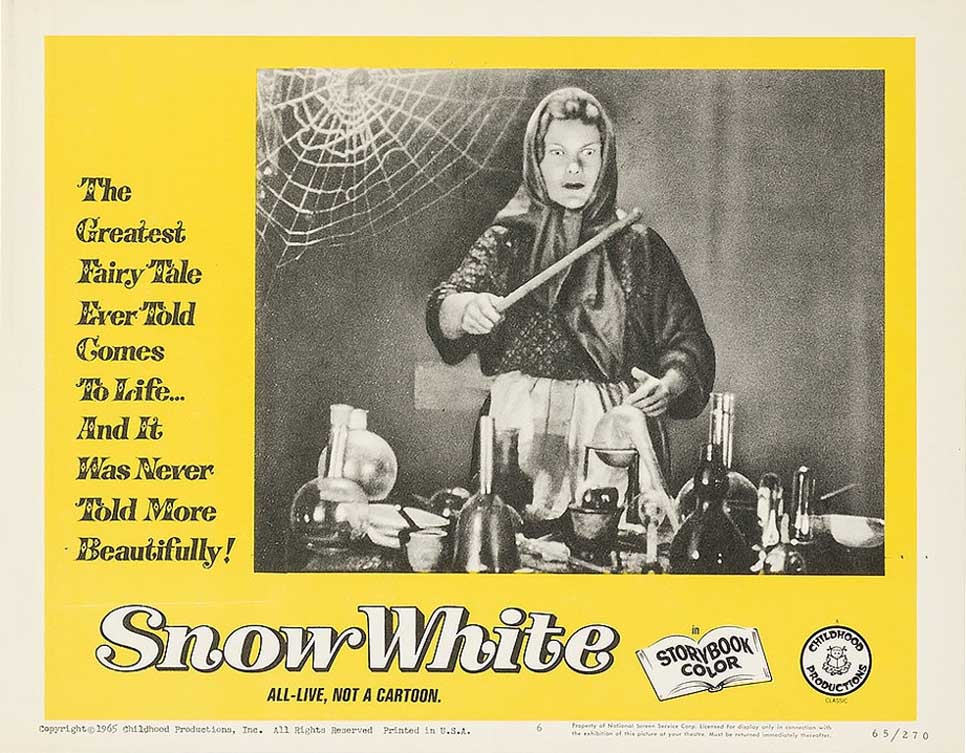Production information
Release dates: November 27, 1955 (Germany), November 1965 (USA)
Studios: Fritz Genshow Films & Schongerfilm GmbH (Germany), Childhood Productions (USA)
German title: Schneewittchen und die sieben Zwerge or Schneewittchen
English title: Snow White
Portuguese title: Branca de Neve
Director: Erich Kobler
Writers: Konrad Lustig & Walter Oehmichen
Composers: Franz Miller & Carl Stueber (Germany), Anne Delugg & Milton Delugg (USA)
Producer: Hubert Schonger
Cinematographer: Wolf Schwan
Editor: Horst Roßberger
Choreographer: Suse Böhm
Main Cast
Snow White: Elke Arendt
The Prince: Niels Clausnitzer
The Queen: Addi Adametz
Hunter: Dietrich Thoms
Chambermaid: Zita Hitz
Young Moor: Erwin Platzer
Snow White’s mother: Renate Eichholz
The Seven Dwarfs: dancers of the Suse Böhm company
Back to References to Snow White from other studios

Snow White 1955: A German Adaptation
In 1955, Fritz Genschow produced Snow White in Germany, inspired by the popularity of Walt Disney’s Snow White and the Seven Dwarfs, which had been introduced to German audiences in 1950. Genschow, already known for his adaptations of classic fairy tales like Hansel and Gretel, sought to create his own version of the beloved story. However, while Disney’s influence is apparent, this Eastmancolor production also demonstrates unique creative choices that distinguish it from the animated feature.
Similarities to Disney’s Snow White
Certain elements of the film clearly draw inspiration from Disney’s 1937 animated classic. The Queen meets her end when struck by lightning, mirroring her demise in Disney’s version. Additionally, the hunter’s appearance and demeanor resemble the cartoon depiction. The Queen’s lair, complete with potions and a magical atmosphere, also evokes the aesthetic of Disney’s film. Moreover, music plays a central role, as in the animated feature. Both versions include songs sung by the dwarfs that punctuate the narrative, although the melodies and lyrics differ across the German and English versions.
The Originality of the 1955 Film
Despite its Disney-inspired elements, the German adaptation introduces notable differences. For instance, the dwarfs’ cottage is transformed into a massive two-story building. The mirror speaks with a feminine voice, and the Queen disguises herself and visits Snow White three separate times, staying closer to the Grimm brothers’ original tale. The hunter’s role is expanded, and unlike Disney’s version, Snow White awakens not from the Prince’s kiss but because the poisoned apple dislodges from her throat when the glass coffin is moved.
The film’s visual elements also reflect a mix of influences. While the costumes evoke a whimsical medieval aesthetic, the furniture in the Queen’s castle aligns more with the 18th century. Furthermore, the castle exteriors were filmed at the iconic Neuschwanstein Castle, a 19th-century structure, adding an anachronistic yet picturesque touch.
The dwarfs are another distinct feature of this adaptation. They are portrayed by children from the Suse Böhm dance group, with choreography by Böhm herself. Each dwarf has a name—Wurzel, Klaps, Flink, Troll, Purzel, Tröpfchen, and Bimbam—but their personalities are not particularly differentiated. Their singing, including songs like Tripp-Trapp, Tripp-Trapp, Bergauf-Bergab, adds charm to the narrative, and Snow White herself sings during her chores.
The English Dub: Challenges and Changes
The English version of the film, released a decade later, reveals both creative decisions and limitations. Either the production company, Childhood Productions, lacked access to the original music and effects tracks, or they deliberately replaced them. For example, in the English version, distinct musical notes accompany the three drops of blood falling into the snow—a detail absent in the German version.
Paul Tripp, the founder of Childhood Productions, serves as the narrator and is the only credited actor in the English voice cast. Unfortunately, some translation choices detract from the film. The original German dialogues were in rhyme, but this poetic quality was lost in translation, leading to awkward and sometimes humorous moments. For instance, Snow White’s hysterical interruptions during her conversation with the hunter make the scene unintentionally comedic.
The dubbing decision to have the dwarfs’ voices played by children was retained, but their personalities remain underdeveloped. The film’s pacing also suffers in parts, with unnecessary focus on mundane details such as the Queen’s servant summoning the hunter or his slow movements through the castle.
Although Snow White 1955 pays homage to Disney’s iconic version, it also carves out its own identity with unique visual choices, adherence to Grimm’s narrative elements, and distinct musical interpretations. However, the English dub highlights some of the challenges of translating a culturally specific work, leading to both endearing and awkward moments. Despite its flaws, this German adaptation remains a fascinating example of how one story can inspire different interpretations across cultures and media.
Trailer
This is the restored HD trailer showcasing the lovely colors of this film, so often remembered through old prints on VHS.









